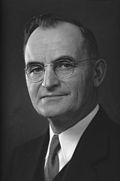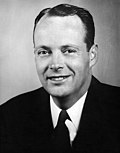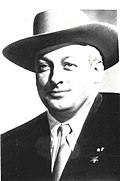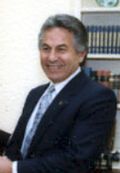List of governors of New Mexico
From Wikipedia, the free encyclopedia
The governor of New Mexico is the head of government of New Mexico and the commander-in-chief of the state's military forces. The governor has a duty to enforce state laws, the power to either approve or veto bills passed by the New Mexico Legislature, to convene the legislature at any time, and to grant pardons.
Twenty-eight individuals have held the office of governor of New Mexico since the state's admission to the Union in 1912, two of whom—Edwin L. Mechem and Bruce King—served three non-consecutive terms. King holds the record as New Mexico's longest-serving governor, with 12 years of service. William C. McDonald, the first governor, took office on January 15, 1912. The first woman to serve as Governor was Republican Susana Martinez, who served from 2011-2019. The current officeholder is Michelle Lujan Grisham, who took office on January 1, 2019, as the first elected female Democratic governor of the state.
List of governors
Summarize
Perspective
On August 18, 1846, American forces led by Stephen W. Kearny captured Santa Fe, capital of the Mexican territory of Santa Fe de Nuevo México.[1] A code of laws known as the Kearny Code was established on September 22, 1846.[2] The region remained under military control until formally annexed by the United States on July 4, 1848. Following Kearny's departure for California on September 26, the chief military officer in the territory was Col. Sterling Price until October 11, 1848; Lt. Col. John M. Washington until October 23, 1849; and Col. John Munroe until the territory was organized.
Kearny appointed Charles Bent as governor before he left for California; Bent would be assassinated during the Taos Revolt on January 19, 1847. Col. Price appointed Donaciano Vigil as acting governor. A statehood convention chose Henry Connelly as governor on June 20, 1850, but this was never recognized by the federal government.
Territory of New Mexico
New Mexico Territory was organized on December 13, 1850.[3] It would remain a territory for 62 years.
| No. | Governor | Term in office[a] | Appointing President | |
|---|---|---|---|---|
| 1 |  |
James Calhoun (1802–1852) [4] |
January 9, 1851[b] – July 2, 1852 (died in office)[c] |
Millard Fillmore |
| 2 |  |
William Carr Lane (1789–1863) [7] |
July 15, 1852[d] – May 6, 1853 (successor appointed)[e] |
Millard Fillmore |
| 3 |  |
David Meriwether (1800–1893) [11] |
May 6, 1853[f] – August 17, 1857 (successor appointed)[g] |
Franklin Pierce |
| 4 |  |
Abraham Rencher (1798–1883) [14] |
August 17, 1857[h] – May 24, 1861 (successor appointed) |
James Buchanan |
| 5 |  |
Henry Connelly (1800–1866) [17] |
May 24, 1861[i] – January 15, 1866 (successor appointed)[j] |
Abraham Lincoln |
| 6 |  |
Robert Byington Mitchell (1823–1882) [22] |
January 15, 1866[k] – May 28, 1869 (resigned)[l][m] |
Andrew Johnson |
| 7 |  |
William A. Pile (1829–1889) [26] |
May 28, 1869[n] – July 27, 1871 (successor appointed) |
Ulysses S. Grant |
| 8 |  |
Marsh Giddings (1816–1875) [28] |
July 27, 1871[o] – June 3, 1875 (died in office)[p] |
Ulysses S. Grant |
| 9 |  |
Samuel Beach Axtell (1819–1891) [32] |
June 8, 1875[q] – September 4, 1878 (suspended)[r] |
Ulysses S. Grant |
| 10 |  |
Lew Wallace (1827–1905) [36] |
September 4, 1878[s] – May 5, 1881 (resigned)[t] |
Rutherford B. Hayes |
| 11 |  |
Lionel Allen Sheldon (1828–1917) [40] |
May 5, 1881[u] – May 23, 1885 (successor appointed) |
James A. Garfield |
| 12 |  |
Edmund G. Ross (1826–1907) [43] |
May 23, 1885[v] – April 2, 1889 (successor appointed) |
Grover Cleveland |
| 13 |  |
L. Bradford Prince (1840–1922) [47] |
April 2, 1889[w] – April 7, 1893 (successor appointed) |
Benjamin Harrison |
| 14 |  |
William Taylor Thornton (1843–1916) [50] |
April 7, 1893[x] – April 5, 1897 (resigned)[y] |
Grover Cleveland |
| 15 |  |
Miguel Antonio Otero (1859–1944) [54] |
June 2, 1897[z] – January 10, 1906 (successor appointed) |
William McKinley |
| Theodore Roosevelt | ||||
| 16 |  |
Herbert James Hagerman (1871–1935) [58] |
January 10, 1906[aa] – May 3, 1907 (resigned)[ab] |
Theodore Roosevelt |
| 17 |  |
George Curry (1861–1947) [61] |
May 27, 1907[ac] – February 28, 1910 (resigned)[ad] |
Theodore Roosevelt |
| 18 |  |
William J. Mills (1849–1915) [64] |
March 1, 1910[ae] – January 14, 1912 (statehood)[af] |
William Howard Taft |
State of New Mexico
The state of New Mexico was admitted to the Union on January 6, 1912.[67]
The state constitution of 1912 called for the election of a governor and lieutenant governor every four years. The term was changed to two years by a 1914 amendment, and lengthened back to four years in 1970. Governors originally could not succeed themselves; this was changed in 1914 to allow governors to succeed themselves once before having to take a term off. With the lengthening of the term to four years in 1970, this was changed back to prohibiting them from succeeding themselves, but in 1986 it was lengthened back to two terms. A 1962 amendment made it so that the governor and lieutenant governor are elected on a ticket (election).[68] In the event of a vacancy in the office of governor, the lieutenant governor becomes governor.[69]
| No. | Governor | Term in office | Party | Election | Lt. Governor[ag] | |||
|---|---|---|---|---|---|---|---|---|
| 1 |  |
William C. McDonald (1858–1918) [70][71] |
January 15, 1912[72] – January 1, 1917 (term-limited)[ah] |
Democratic[74] | 1911 | Ezequiel Cabeza De Baca | ||
| 2 |  |
Ezequiel Cabeza De Baca (1864–1917) [75][76] |
January 1, 1917[77] – February 18, 1917 (died in office) |
Democratic[74] | 1916 | Washington Ellsworth Lindsey[ai] | ||
| 3 |  |
Washington Ellsworth Lindsey (1862–1926) [78][79] |
February 18, 1917[80] – January 1, 1919 (lost nomination)[78] |
Republican[74] | Succeeded from lieutenant governor |
Vacant | ||
| 4 |  |
Octaviano Ambrosio Larrazolo (1859–1930) [81][82] |
January 1, 1919[83] – January 1, 1921 (lost nomination)[81] |
Republican[74] | 1918 | Benjamin F. Pankey | ||
| 5 |  |
Merritt C. Mechem (1870–1946) [84][85] |
January 1, 1921[86] – January 1, 1923 (did not run)[84] |
Republican[74] | 1920 | William H. Duckworth | ||
| 6 |  |
James F. Hinkle (1862–1951) [87][88] |
January 1, 1923[89] – January 1, 1925 (did not run) |
Democratic[74] | 1922 | José A. Baca (died May 17, 1924) | ||
| Vacant | ||||||||
| 7 |  |
Arthur T. Hannett (1884–1966) [90][91] |
January 1, 1925[92] – January 1, 1927 (lost election) |
Democratic[74] | 1924 | Edward G. Sargent[ai] | ||
| 8 |  |
Richard C. Dillon (1877–1966) [93][94] |
January 1, 1927[95] – January 1, 1931 (term-limited)[ah] |
Republican[74] | 1926 | |||
| 1928 | Hugh B. Woodward (resigned July 1929) | |||||||
| Vacant | ||||||||
| 9 |  |
Arthur Seligman (1871–1933) [96][97] |
January 1, 1931[98] – September 25, 1933 (died in office) |
Democratic[74] | 1930 | Andrew W. Hockenhull | ||
| 1932 | ||||||||
| 10 |  |
Andrew W. Hockenhull (1877–1974) [99][100] |
September 25, 1933[101] – January 1, 1935 (did not run) |
Democratic[74] | Succeeded from lieutenant governor |
Vacant | ||
| 11 |  |
Clyde Tingley (1881–1960) [102][103] |
January 1, 1935[104] – January 1, 1939 (term-limited)[ah] |
Democratic[74] | 1934 | Louis Cabeza de Baca | ||
| 1936 | Hiram M. Dow | |||||||
| 12 |  |
John E. Miles (1884–1971) [105][106] |
January 1, 1939[aj] – January 1, 1943 (term-limited)[ah] |
Democratic[74] | 1938 | James Murray Sr. | ||
| 1940 | Ceferino Quintana | |||||||
| 13 |  |
John J. Dempsey (1879–1958) [108][109] |
January 1, 1943[110] – January 1, 1947 (term-limited)[ah] |
Democratic[74] | 1942 | James B. Jones | ||
| 1944 | ||||||||
| 14 |  |
Thomas J. Mabry (1884–1962) [111][112] |
January 1, 1947[113] – January 1, 1951 (term-limited)[ah] |
Democratic[74] | 1946 | Joseph Montoya | ||
| 1948 | ||||||||
| 15 |  |
Edwin L. Mechem (1912–2002) [114][115] |
January 1, 1951[116] – January 1, 1955 (term-limited)[ah] |
Republican[74] | 1950 | Tibo J. Chávez[ak] | ||
| 1952 | ||||||||
| 16 |  |
John F. Simms (1916–1975) [117][118] |
January 1, 1955[119] – January 1, 1957 (lost election) |
Democratic[74] | 1954 | Joseph Montoya[ak] (resigned April 9, 1957) | ||
| 17 |  |
Edwin L. Mechem (1912–2002) [114][115] |
January 1, 1957[120] – January 1, 1959 (lost election) |
Republican[74] | 1956 | |||
| Vacant | ||||||||
| 18 |  |
John Burroughs (1907–1978) [121][122] |
January 1, 1959[123] – January 1, 1961 (lost election) |
Democratic[74] | 1958 | Ed V. Mead | ||
| 19 |  |
Edwin L. Mechem (1912–2002) [114][115] |
January 1, 1961[al] – November 30, 1962 (resigned)[am] |
Republican[74] | 1960 | Tom Bolack | ||
| 20 |  |
Tom Bolack (1918–1998) [125][126] |
November 30, 1962[127] – January 1, 1963 (successor took office) |
Republican[74] | Succeeded from lieutenant governor |
Vacant | ||
| 21 |  |
Jack M. Campbell (1916–1999) [128][129] |
January 1, 1963[130] – January 1, 1967 (term-limited)[ah] |
Democratic[74] | 1962 | Mack Easley | ||
| 1964 | ||||||||
| 22 |  |
David Cargo (1929–2013) [131][132] |
January 1, 1967[133] – January 1, 1971 (term-limited)[an] |
Republican[74] | 1966 | Lee Francis | ||
| 1968 | ||||||||
| 23 |  |
Bruce King (1924–2009) [134][135] |
January 1, 1971[136] – January 1, 1975 (term-limited)[ao] |
Democratic[74] | 1970 | Roberto Mondragón | ||
| 24 |  |
Jerry Apodaca (1934–2023) [138][139] |
January 1, 1975[140] – January 1, 1979 (term-limited)[ao] |
Democratic[74] | 1974 | Robert E. Ferguson | ||
| 25 |  |
Bruce King (1924–2009) [134][135] |
January 1, 1979[141] – January 1, 1983 (term-limited)[ao] |
Democratic[135] | 1978 | Roberto Mondragón | ||
| 26 |  |
Toney Anaya (b. 1941) [142] |
January 1, 1983[143] – January 1, 1987 (term-limited)[ao] |
Democratic[142] | 1982 | Mike Runnels | ||
| 27 |  |
Garrey Carruthers (b. 1939) [144] |
January 1, 1987[145] – January 1, 1991 (term-limited)[ao] |
Republican[144] | 1986 | Jack L. Stahl | ||
| 28 |  |
Bruce King (1924–2009) [134][135] |
January 1, 1991[146] – January 1, 1995 (lost election) |
Democratic[135] | 1990 | Casey Luna | ||
| 29 |  |
Gary Johnson (b. 1953) [147] |
January 1, 1995[148] – January 1, 2003 (term-limited)[ap] |
Republican[147] | 1994 | Walter Dwight Bradley | ||
| 1998 | ||||||||
| 30 |  |
Bill Richardson (1947–2023) [150] |
January 1, 2003[151] – January 1, 2011 (term-limited)[ap] |
Democratic[150] | 2002 | Diane Denish | ||
| 2006 | ||||||||
| 31 |  |
Susana Martinez (b. 1959) [152] |
January 1, 2011[153] – January 1, 2019 (term-limited)[ap] |
Republican[152] | 2010 | John Sanchez | ||
| 2014 | ||||||||
| 32 |  |
Michelle Lujan Grisham (b. 1959) [154] |
January 1, 2019[155] – Incumbent[aq] |
Democratic[154] | 2018 | Howie Morales | ||
| 2022 | ||||||||
See also
Notes
- Calhoun left the territory on May 6, 1852, and died on July 2; Territorial Secretary John Greiner acted as governor until his successor arrived.[4]
- Meriwether left the territory in May 1857, after which time Territorial Secretary William W. H. Davis acted as governor until he too left the territory in October.[11]
- Connelly left the territory from fall 1862 to May 1863; Territorial Secretary William F. M. Arny acted as governor during this time.[17]
- The nomination of Mitchell's successor specifies that he resigned.[25]
- Mitchell left the territory in November 1866 for almost four months; Territorial Secretary William F. M. Arny acted as governor during this time.[22]
- After Giddings' death, Territorial Secretary William G. Ritch acted as governor until his successor arrived.[28]
- Axtell was suspended by United States Secretary of the Interior Carl Schurz for mishandling the widespread violence in the territory.[32]
- Wallace resigned, disillusioned with the violence in the territory and the power held by the "Santa Fe Ring".[36]
- President Theodore Roosevelt demanded Hagerman's resignation in April 1907 due to political pressure and controversial purchases. Territorial Secretary J. W. Raynolds acted as governor until his successor arrived.[58]
- Curry resigned due to disagreements with United States Secretary of the Interior Richard A. Ballinger.[61]
- Mills served as governor until statehood, and ran unsuccessfully for one of the first United States Senate seats for New Mexico.[64]
- Under a 1914 amendment to the constitution, governors were ineligible for two years after having served two consecutive terms.[73]
- Represented the Republican Party
- The constitutional start date of the term was January 1; however, in 1939 this was a Sunday, so Miles was sworn in the next day.[107]
- Represented the Democratic Party
- The constitutional start date of the term was January 1; however, in 1961 this was a Sunday, so Mechem was sworn in the next day.[124]
- Mechem, who had already lost re-election, resigned to be appointed to the United States Senate by his successor.[114]
- Under a 1970 amendment to the constitution, governors were ineligible to succeed themselves.[137]
- Under a 1986 amendment to the constitution, governors who have served two terms are ineligible until another term has passed.[149]
- Lujan Grisham's second term began on January 1, 2023,[156] and will expire January 1, 2027; she will be term-limited.
References
External links
Wikiwand - on
Seamless Wikipedia browsing. On steroids.
